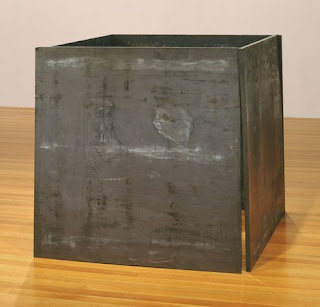
I think the Richard Serra retrospective at MoMA is a good opportunity to talk about phenomenological art and how it changed our understanding of what art could be. I say it's a good opportunity because Serra is one of the best and because I don’t think people sufficiently appreciate the new aesthetic experiences made available in the late 60’s. People, there is more to the late 60’s than conceptual art!
To recap: as we’ve been told (over and over again), in the 1960’s people asked the big questions and really changed things around socially, culturally, politically, etc. Artistically, the 60’s were no different, with "post-minimal" artists like Bruce Nauman, Eva Hesse and, our hero, Richard Serra questioning and gradually disassembling modernism’s assumptions (using Jasper Johns as a guide). Judging by the sampling of his early work in the MoMA show Serra asked several timely questions, including: "Is it art if I use industrial materials instead of artistic ones? Is it sculpture if it is placed directly on the floor or hung on the wall? Is it sculpture if it shows the process of its making?" Of course, these questions are banal now (today the early work is difficult to understand without knowledge of what sculpture was circa 1965), but trust me: at the time they were significant. And trust me, this questioning lead to something significant, as well.
And this is where I think the misunderstanding happens. Because I know what you’re thinking: “All this questioning lead to conceptual art and the diffusion of the aesthetic experience into theory, language, and context,” you say, “Boring!” And while that is partially true, the late 60’s also introduced something called “phenomenology” (or “theatricality”) as an art experience. Basically, phenomenological art focused on giving the viewer a physical or bodily experience more than an intellectual or visual one. So instead of losing yourself in an image of a landscape or pondering a jargon-filled text, phenomenological art made you feel with your body, and often the experience was immediate, unexpected, and overwhelming. And identifying this latent aspect of art (a painting is an image and, also, a physical object) was more or less innovative! For example, while Anthony Caro’s sculpture might not move you, Serra’s "One Ton Prop (House of Cards)" would definitely move you…the hell out of the gallery before the huge steel slabs fell on your ass!!! And while these “Prop” works may not be as threatening today (behind glass partitions at the MoMA they’re history, not sculpture), back in the late 60’s in some rundown loft they were (reportedly) pretty badass.

At the MoMA retrospective one can discern how, over the course of his career, Serra has continued to develop more physical experiences for the viewer, while also incorporating context and image to greater or lesser degrees. So, not only are these works physically rich, but they are visually and intellectually rich as well. However, the emphasis remains on the viewer’s physical experience of the objects. I mean, just try not to feel while walking through his Torqued Ellipses or the newer work on show in the MoMA’s contemporary galleries on the 2nd floor. I double dog dare you.
Now that you’ve lost that dare, observe all the other visitors experiencing, exploring, and (holy shit) enjoying Serra’s Ellipses. No prior knowledge is needed, no museum copy is required: this is great art. So, I say unto you, contemporary artists, claim the bounty that is yours! Reconsider your understanding of late 60’s art and embrace the phenomenological! And the next time you find yourself in the presence of contemporary art, notice: does it make you feel before you think? For contemporary art is often flooded with words, theories, and strategies but often lacking in feeling.
This blog entry can also be found on my blog, right here.
2 comments:
Hi Brian,it was a very thoughtful blog reading today here,many more to learn from your posts,i love all the artists and their works showcasing here.I'll be a regular visitor for sure.
Thank you for your kind words.
This article was by Mr. Nathan Townes-Anderson. He is one of our contributers. :P
Post a Comment